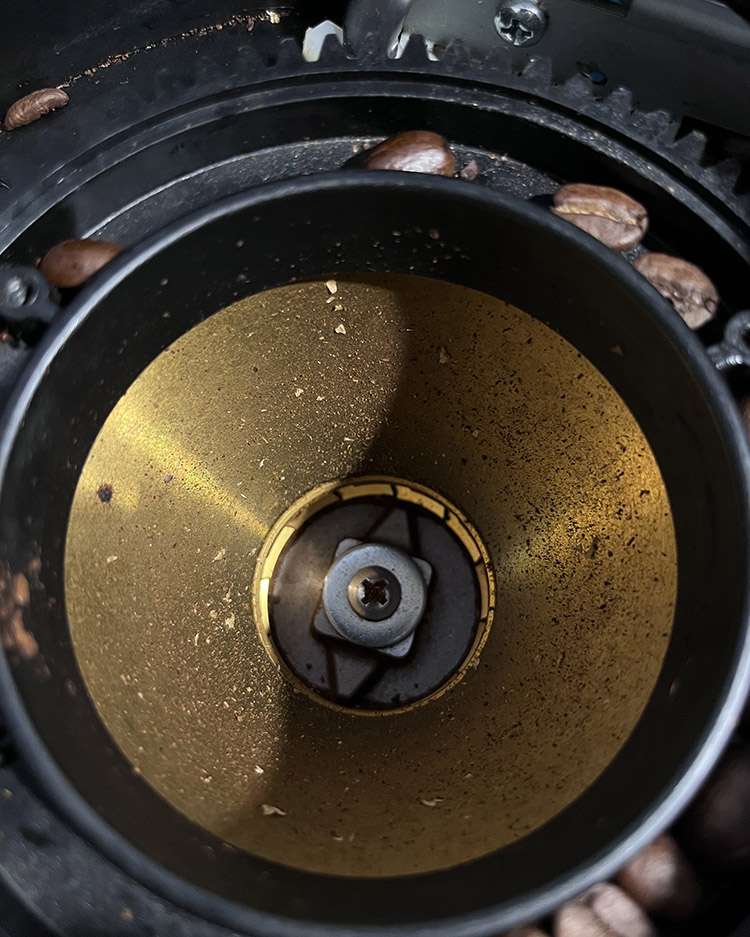On the way to the perfectly brewed coffee, you always come to the point where you are told that you should grind the beans fresh. That's true! Freshly ground is best, but with which grinder or which grinder? And here many people compare the grinders: conical grinder vs. ceramic grinder. This comparison is well-intentioned, but it's a bit flawed , since conical is a grinder shape and ceramic is a grinder material. That's why we're now doing a big coffee grinder grinder comparison and taking a close look at both materials and shapes .
Coffee grinder - grinding mechanism in comparison – Why is the coffee grinder important
In addition to the coffee machine, the coffee grinder is one of the most important tools for brewing good, tasty coffee. They are used to grind coffee beans into the right particle size for the respective preparation method . There are different types of grinders. Choosing the right coffee grinder depends on various factors, including the desired grind level, your budget and your personal preferences. However, a high-quality coffee grinder is crucial to ensure consistent grinding and optimal extraction for delicious coffee.
Coffee grinder - grinding mechanism in comparison – hand grinders
These are manual grinders that are operated by hand . They are usually compact, portable and easy to use, making them ideal for use at home or on the go. They often offer good control over the grind size and can deliver a consistent grind for different preparation methods.
Coffee grinder - grinding mechanism in comparison – Electric impact grinders
Electric impact grinders use impact blades to grind the coffee beans. They are easy to use and usually offer a fast grind. However, they can tend to produce very uneven particle sizes , which can lead to a less consistent extraction.
Coffee grinder - grinding mechanism in comparison – conical grinders
Conical grinders use conical burrs to grind the coffee beans. They provide a more consistent grind and better control over the grind size compared to impact grinders.
Coffee grinder - grinding mechanism in comparison – flat grinders
Flat grinders use flat burrs to grind the coffee beans . They offer a similar to good or even better grind quality as conical grinders and are well suited for making espresso, filter coffee and other grinds. Flat grinders are often found in commercial settings but can also be used for home use.

Coffee grinder - grinding mechanism in comparison – advantages of a good grinder
A quality coffee grinder offers several benefits. Firstly, it delivers an even and consistent grind, which is crucial to ensure optimal extraction and therefore a delicious coffee. Good coffee grinders are able to precisely adjust the grind level to meet the needs of different brewing methods, be it for espresso, filter coffee or French press. Secondly, they are durable and reliable, with high-quality grinding discs that provide consistent performance even with regular use. In addition, many high-quality coffee grinders offer additional features such as a timer control, digital display and an automatic shut-off function for an improved user experience
Coffee grinder - grinding mechanism in comparison – Disadvantages of a bad grinder
In contrast , poor quality coffee grinders can cause a variety of problems. A poor quality coffee grinder will often deliver an uneven grind with irregular particle sizes, which can lead to inconsistent extraction and an inadequate flavor experience. Additionally, poor quality coffee grinders can tend to generate excessive heat, which can warm the coffee during the grinding process , resulting in a burnt or unpleasant taste. Poor quality coffee grinders can also be less durable and wear out faster, which can lead to unreliable performance and increased maintenance
Coffee grinder - grinding mechanism in comparison – why the grinder is particularly important
The grinder is particularly important in a coffee grinder, as it has a significant impact on the quality of the ground coffee beans and therefore also on the taste of the coffee. The grinder determines factors such as even grinding, adjustability of the grinding level, aroma retention through low heat development , and the longevity of the grinder. We will now take a closer look at the differences between the grinders in terms of shape and material.
Coffee grinder - grinding mechanism in comparison – conical grinder
A conical grinder consists of two conical grinding discs, one of which rotates and the other remains stationary or also rotates. Teeth or sharp edges are milled into both grinding discs. Conical grinders grind the coffee beans by compressing and cutting between the two grinding discs. These grinders require more powerful motors than flat grinders , but they can work at lower speeds. The particle size distribution is more inconsistent than with grinding discs. Conical grinders produce a relatively large proportion of fine particles. This is not a problem with espressos and coffees that have been extracted quickly. However, this is a disadvantage for coffees that sometimes brew for longer.
Coffee grinder - grinding mechanism in comparison – disc grinder
A disc grinder usually has two discs or rings that are very similar or even completely identical . One of the two discs rotates, the other is stationary. Here, too, sharp edges are milled into the discs. The beans fall into the grinder, are ground and then sent into the grinding gap by the radial force. Grinding discs can be installed horizontally or vertically in the mill . With a vertical design, the mill also needs a conveyor belt to transport the beans in the right direction. Grinding discs produce a more consistent particle size distribution.

Coffee grinder - grinding mechanism in comparison – grinder material
Grinders or grinding discs can be made of many different materials. They are available in ceramic, titanium, metal alloy, with or without a coating. All of these factors give the grinder different properties, such as heat development, degree of wear, durability, etc. All of this in turn affects the aroma of the cup.
Coffee grinder - grinding mechanism in comparison – ceramic grinder
Ceramic burrs use grinding discs or cones made of ceramic materials, which are usually very hard and durable. Ceramic burrs tend to last longer than metal burrs because ceramic is less prone to wear and corrosion. They provide an even and consistent grind, as well as less heat buildup during the grinding process, which preserves the flavors and oils in the coffee. They are often quieter in operation and produce less noise than metal burrs.
Coffee grinder - grinding mechanism in comparison – metal grinder
Metal burrs use burrs or cones made of metal, typically a steel alloy with or without a coating such as titanium . Metal burrs are durable and can last a long time even with heavy use, although they tend to be more susceptible to wear and corrosion than ceramic burrs. They also provide a consistent grind, but can tend to generate more heat during the grinding process , which may result in a slight loss of flavors and oils in the coffee. Metal burrs may require a little more care and maintenance to prevent contamination and rust buildup. They can be noisier in operation than ceramic burrs , especially at higher grinding speeds.
Coffee grinder - grinding mechanism in comparison – advantages / disadvantages of different material
There are also other materials for grinders such as wood, stone and plastic. However, these are usually so rare and often used in cheap or low-quality grinders (plastic) or only in decorative or traditional grinders (wood and stone) that it is not really worth talking about them here. Only grinders with titanium grinders are part of this discussion, as they are extremely robust and rust-resistant. They offer excellent grinding quality and good durability.
Coffee grinder - grinding mechanism in comparison – help with the purchase
So, now you know the differences and you still don't know exactly what kind of grinder you should buy. Especially since the price differences or let's say the range of prices is very large . The questions you should ask yourself before buying a grinder are:
- What preparation methods do you use?
- How often (per day) do you drink coffee?
- What is your budget?
Coffee grinder - grinding mechanism in comparison – preparation method
If, for example, you only have one portafilter, then an espresso grinder is perfectly adequate . There are also special grinders – such as the Fellow Ode – which are made specifically for coarser grinds for filter methods. Then there are so-called shop grinders, large blocks like the ones you find in supermarkets, which often have all grinds from espresso to cold brew. However, this creates more dead space in the grinders , where coffee grounds can collect and smoke out over time. You can then taste this in later grinds, when some of the powder comes along with them. However, over time more and more high-quality grinders are coming onto the market which advertise that they can handle all preparation methods equally .
Coffee grinder - grinding mechanism in comparison – capacity
Capacity affects how much roasted coffee beans your grinder can process and how much coffee it has to grind per day. If you drink once or twice a day, then you can definitely use a hand grinder. It's fun, there's something meditative and ceremonial about it. But if you want to grind more or more often, then you should think about an electric grinder . The load capacity is important with electric grinders - as the grinders work at quite high speeds and can get hot. You can often find this value in the manufacturer's information and it describes how much coffee you can grind without the motor overheating and suffering as a result.
Coffee grinder grinder comparison – budget
As mentioned, the range is very wide. You can buy almost anything from hand grinders for 50 euros to electric grinders costing several thousand euros . But don't just look at the purchase price, but also at wearing parts such as the grinder and seals - especially if the grinder is used commercially. In very busy coffee shops, grinders are often replaced after 2 to 4 years. For home use - unless you are an extreme coffee drinker - a grinder will last you significantly longer.
Coffee grinder - grinding mechanism in comparison – conclusion
We hope we were able to help with the question of conical grinder vs ceramic grinder vs metal grinder vs disc grinder. You are also welcome to simply take a look in our shop and compare a few grinders there. The most important thing for you, however, is simple: how often you use it, how finely or coarsely you want to grind and how much it should cost. Then you will definitely find the right grinder with the right grinder for your purposes.


